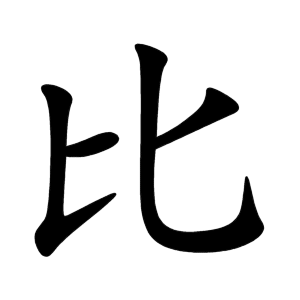比
- to compare;
- to be side by side;
- to cling;
- to conspire;
- to connect;
Etymology
Its variant form includes 夶, which is composed of two 大 (big) characters combined. According to the Shuowen Jiezi (說文解字), the seal script form depicts two 人 (person) characters reversed and placed side by side.
Since two 人 characters together can represent the meaning "to follow" (从), reversing them symbolizes closeness or intimacy, which corresponds to the meaning of 比 ("to compare" or "to be close").
Usage in Korean
When used as a radical or semantic component, it conveys meanings related to comparison, and characters containing the strokes of 比 are categorized under this radical.
比
견줄
비
gyeonjul
bi
Kangxi radical:81
Strokes:4
Unicode:U+6BD4
Cangjie input:
- 心心 (PP)
Composition:
- ⿰⿺ 𠄌 一 匕 (G H T)
- ⿻ 𠃏 ⿰ 一 一 (G H T)
- ⿰⿱ ⺊ ㇀ 匕 (J K V)
